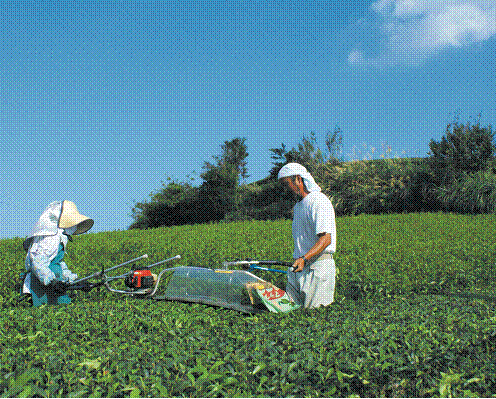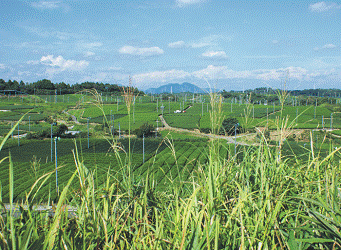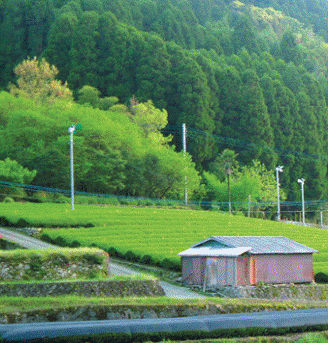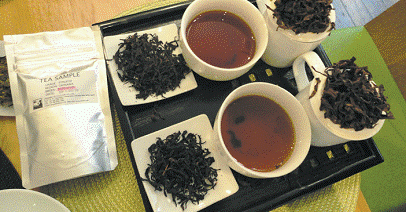Japanese Teas Low in Export, High in Demand- By Barbara DuFrEne

Just 18 months after the devastating Fukushima earthquake on March 11, 2011, the country’s tea production fully recovered during 2012, with exports fetching higher prices than ever before. The proactive and transparent communication and follow up monitored by the Japan Tea Exporters Association, based in Shizuoka, under the guidance of its president, Kotaro Tanimoto, greatly contributed to clarifying and improving the supply situation.
With an average annual output of around 100,000 metric tons of tea, of which more than 95 percent is green tea, and of which only about 3 percent available for export, Japan’s tea market profile is really unique today.
Tea was introduced to Japan from China in the late 8th century by Buddhist monks. Grown at the monasteries for their own use and at the palaces of the local feudal families, the Japanese “way of tea” was formally enshrined and codified by tea masters Takeno Jôo (1502-1555) and Sen no Rikyu (1522-1591). Tea became a popular drink in Japan only about 250 years ago. Commercial plantations and industrial processing methods were developed from the mid 18th century onwards.
The geographical setting for Japan’s teas begins at the archipelago from northern Hokkaido Island to southern Kyushu Island, down further south to the Ryu Kyu Islands chain. Some fantastic black teas are grown in Okinawa. This explains the wide range of first flush picking dates that starts by the end of February in Kagoshima, but only in mid May in the most northern tea region of Saitama.

|
of labor and a lack of plant material. In order to meet the strong demand, the tea industry developed appropriate mechanization of tea growing and tea harvesting together with the introduction of highyield and high-quality cultivars, which has remained a unique feature of the Japanese tea market.
At that time, the Yabukita cultivar, bred by a grower from Shizuoka in 1908 and officially registered in 1958, appeared to be the most suitable tea bush. With its elegant aroma and strong “umami” taste, combined with its high yield and upright branches, the Yabukita cultivar is ideal for mechanical harvesting. The clonal propagation offered faster growth than seed produced bushes and starting out from the Shizuoka tea region, the Yabukita tea bush spread to all other Japanese tea regions. Today it covers about 80 percent of the archipelago’s total tea acreage. Many more excellent cultivars were developed in the 1980s based on the characteristics of early harvest season, good cup quality, high yields and disease resistance. The aim was to improve market stability and to widen the range of tea beverages and furthermore to develop the use of tea in the food and health food sectors. Although 52 cultivars were registered with the Japanese Ministry of Agriculture, Yabukita remains today by far the dominant variety, (75 percent of production) followed by Yutakamidori (5 percent), which was registered in Kagoshima in 1966 for its early harvest and strong Gyokuro flavor.
 |
The six other main bush varieties selected by the Japanese Ministry of Agriculture are:
• Okumidori cultivar—particularly adapted for Tencha production and is grown in Aichi, in the central plains of Honshu Island,• Okuhikari cultivar—selected from the northern region and the cooler mountain areas,
• Saemidori cultivar—selected for its high amino acid content and
• Benifuki cultivar—selected for its antiallergy potential due to its content of methylated catechins.
Two more cultivars have gained some economic importance because they make high quality black tea and thus cater to a premium niche market demand. Developed with parentage from India, the Benihikari cultivar makes a high quality black tea with a strong incense aroma, whilst the Benihomare cultivar is considered to be the best black tea cultivar in Japan. Both are grown by a small tea cooperative in Okinawa Island and their first flush with a crop of less than 800kg per year is amongst the most expensive teas in Japan.
Greatness of GreenAll the tea regions in Japan operate mechanical harvesting with only the finest crops being hand picked. Additionally, all tea regions also produce all types of green tea, however, some are
specialized. Uji, near the former imperial city of Kyoto, the oldest traditional tea region in Japan, focuses on Gyokuro production. In Aichi, next to Uji, where the world’s biggest Matcha producer is located, the company Aiya specializes in Okumidori bushes for Tencha production from which the Matcha is made.
The main types of Japanese green teas are:• Sencha: a full sun, spring harvested, steam processed intensely green and strongly “umami” flavored green tea; represents about 80 percent of production,
• NB: its new crop, from the first spring picking, is called Shincha, or Ichiban cha,
• Gyokuro: translated means “dew drop.” Shade grown by covering the bushes about 20 days before harvest, this tea has a deep green intense vegetal flavoring, whilst sweet tasting cup; represents less than 1 percent of the production,
• Tencha: also shade grown but with unrolled, flat dried leaves—the prime material for Matcha production,
• Matcha: the premium quality tea powder made from Tencha by grinding the dry leaf material in stone mills; represents about 1.1 percent of the production,
• Bancha: the full-sun summer- and autumn-harvested larger leaves, which have less flavor but provide good cups for everyday consumption,
• Kukicha: made from the twigs and sticks left over from the Sencha, Tencha and Gyokuro processing and which give pleasant light green and very refreshing cups.
It is notable that Japan exports less than 3 percent of its production. However, its exports are certainly the finest teas because the unit price per kilogram of the exported teas amounts to USD $24.88 in 2011, compared with USD $6.50 per kilogram of teas from Taiwan and USD $4.51 per kilogram of teas from Sri Lanka, according to the London-based International Tea Committee’s Annual Bulletin of Statistics 2012. It is also noteworthy that Japanese teas have the reputation of being beneficial to health with high polyphenol contents and catechins, which include the free-radicals scavenger Epigallocatechingallate (EGCG). Because of their freshness and delicate structure, Japanese leaf teas are steeped very briefly—less than a minute— and with water that has been cooled down after boiling to about 60 degrees Celcius only. This gentle treatment allows to better preserve the various antioxidant components and also the amino acids contained in the leaves. As to Matcha, which is not an infused cup but the ground leaf substance, the world’s biggest Matcha producer Aiya, quotes the highest ever amount of antioxidants contained in a cup of Matcha, calculated as 1573. This compares with goji berries at 253 or pomegranates at 105 (expressed as ORAC value: Oxygen Radical Absorbing Capacity).
Growth and Innovation With available lands limited by the central mountain range with their high volcanoes, such as majestic Mount Fuji and still smoke spitting Mount Sakurajima, Japanese tea production is closely monitored for continued improvement and innovation. Organic production, which was initiated in 2002, is clearly on the rise. Another new trend is marketing mono-varietal teas, with the name of the cultivar on the label. Furthermore, new process technologies are currently being developed to produce microbially fermented dark teas, along the ancient Chinese “wetting and piling” method. So far, Western consumers remain keen on the traditional fine green teas. When the vacuum-packed silver foil pouches of just 30gr or 50gr of spring picked fine teas reach the West, the tea aficionados are always ready to pay very high prices for those exquisite cups.
Barbara Dufrêne is the former Secretary General of the European Tea Committee and editor of La Nouvelle Presse du Thé. She may be reached at: bdufrêne@orange.fr.
